
 |
|||||
|
|
|||||
|
|
|
|||||
|
|
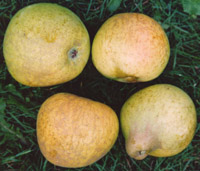 |
LEMON PIPPIN A very old apple, thought to be English or Norman, in existence in England before 1685. Oval fruit, with lemon yellow skin and flesh often covering the stalk, giving it the same shape as a lemon. It has crisp, sweet flesh with a slight tang. Regarded as dual purpose in the eighteenth and nineteenth centuries, when it was dried and used for tarts as well as being eaten for dessert. It softens when cooked, but keeps its shape and has a wonderfully sweet and rich flavour. In the eighteenth century it was said to be so popular that many planted it in preference to all other varieties. The fruit stores well and may be kept until April. Reliable cropper. Pollination Group 5 |
||
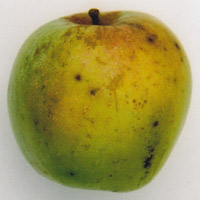 |
LEMON ROY A Gloucestershire apple, associated with the Minsterworth area, little known outside the county until made known by Charles Martell and the Gloucestershire Orchard Group. A very good apple both for eating and cooking. It is very late to ripen and is a little tough if tried too early, but in late November it becomes more juicy with a rich, sweet flavour, lemony rather than acidic. When cooked it is a little resistant to softening but poaches well in syrup or on a tart with butter to retain moisture. The medium sized oval apples, more tall than round, have a yellow skin, patched with broken amber russet. Late into leaf. Pollination Group 5 |
|||
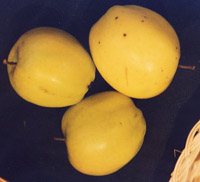 |
LEMON
SQUARES Known as Lemon Square from the 19th century, but in the
1798 Catalogue of Clark and Atkinson, Nurserymen of Keswick, Cumberland
and Keighley, Yorkshire it was listed as Lemon Squares and as an eating
apple, from October to March. They also listed Hutton Squares, which later
became known as Hutton Square. It seems likely that such apples were called
squares, possibly from their angled, square shape. An earlier provenance
exists, as follows. In 1883, it was exhibited, by Mr Charles Crossland,
the Gardener at Beachwood, Arnside, Westmorland, at the National Apple
Congress. Whether he called it Lemon Square or Lemon Squares is unknown.
It was listed as Lemon Square, but the author of the report might just
have adopted current usage. Crossland reported that “the apples
I have sent may not be as fine as might be anticipated, but as they are
gathered from such old trees, much finer could not be expected”.
The Congress observed that the examples were all small, very deficient
in colouring, being green and unripe looking, and all more or less acid.
Mr Crossland noted (in 1883) that all the apples he exhibited had been
grown on the Beachwood Estate for over 200 years, presumably from records
kept by Mr Saul, a former owner of Beachwood. That would put the age of
this apple at pre-1683. Barron, the author of the report described it
as a dessert apple; small, oblong, angular, yellow, early season and ‘worthless’,
but he often made such rash judgements from fruit already acknowledged
to be atypical. The Clark and Atkinson catalogue and subsequent references
deny this being an early season apple. In 1820 it was listed by Alexander
Forbes, gardener at Levens Hall Nursery at Kendal, Cumberland and said
to be above medium size, pale yellow and red, and in use from November
to December. Perhaps it would be a little earlier in the South. The apple
now known was ‘rediscovered’ by Chris Braithwaite, Head Gardener
at Acorn Bank. It has also been suggested it was local to the Eden Valley
in Westmorland. A suggestion that the apple takes its name from its use
in local pastry squares, is unconvincing as many different apples would
be used and pastry squares were nationally, not locally, commonplace.
Grown with us in the South Midlands, it is middle to late season and a
juicy, pleasant eating apple which, in late years, will last to December.
Pollination Group 3 |
|||
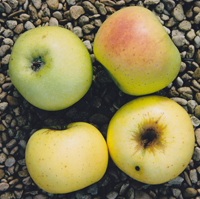 |
LEMON SUMMERING Another rare escapee from the literature of the ages, probably never known outside of Lincolnshire. It was brought to our attention several years ago by Gill and Charles Thornton, of Brant Broughton, Lincolnshire. Their historic property was held by Charles Thornton’s family for many years and his grandmother recorded that this particular ancient apple tree was called Lemon Summering and was very rare. In 2013 Charles Thornton kindly sent us scions and fruit. The name suggests a summer apple, but it appears to be at the peak of ripeness in Lincolnshire in mid September. The rounded and flattened pale green apples turn pale yellow when ripe and sometimes have a warm blush from the side in the sun. The primary use is for cooking, when they pulp down quickly for purées if stored for a while, but will keep their shape entirely when used first ripe. Without sugar the taste is a little sour, rather than sharp, but with a little sugar the flavour is rich and fully rounded, and good for an early/middle season apple. When ripe, they are sweet enough to enjoy as eating apples, but without any great character. The apples we were sent actually stored into January, retaining a good lemony flavour, but becoming a little dry and soft. The first generation of trees here surprised us by setting fruiting spurs in their first year. Pollination Group 4 | |||
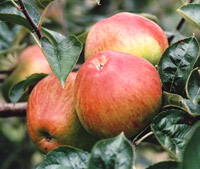 |
LEWIS’S
INCOMPARABLE History does not record who Lewis was, but the apple
existed in the 18th century. It was in the London Horticultural Society
collection in 1826. In the Gardener’s Chronicle of 1898 it was said
that Mr Clayton of Grimston Park, Tadcaster, Yorkshire, had reported picking
30 stones of fruit from a 100 year old tree. Obviously, it is a large
apple, dual purpose, the trees being vigorous and producing abundant crops.
Hogg considered it second rate, but Scott rated it top quality. The fruit
is conical and irregular with one side higher. The skin is dark red and
streaked in the sun, and yellow with a few streaks in the shade, speckled
with russet dots. The flesh is crisp, juicy, tangy and aromatic. In use
from December to February. It keeps its shape when cooked. Pollination
Group 6 |
|||
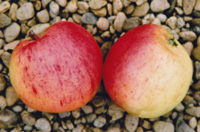 |
LINNET SANGWINE The late Linnet Sangwine was a well known character in Bampton, Oxfordshire, living in her central thatched cottage. Many years ago, while in Bampton visiting another old tree, we were taken across the road to see Linnet’s back garden apple tree. It was very old, hollow and leaning badly. The apples, seemingly near ripe on the tree, were oblong, small to medium, very late in season and were said to stay very firm until March. Linnet said that she found them to be of no use and wondered why the tree had ever been kept there. She said the flavour was poor for eating raw and that the apples did not soften when cooked. We assumed it must be a pickling or jam apple, but took a cutting simply because it was very old and might prove interesting. When our tree here fruited we were most surpised at how good the apples were. Perhaps it was the age of the original tree and the fact that it was in part shade, that made the fruit so poor in Linnet’s eyes, but here it is ripe in mid-October, with fine, crisp and very juicy sweet flesh, with a lively floral flavour, and very refreshing. The apples are small, oblong to round, yellow, with a strawberry flush and flecks and will last well into November, possibly later. Pollination Group 4
|
|||
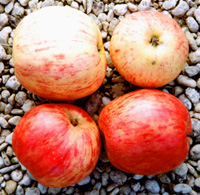 |
LITTLE AVEBURY Neolithic Avebury has the largest prehistoric stone circle and avenues in the world and is as old, if not older, than Stonehenge. It is thought to have existed in 2850BC or earlier. A short walking distance to the west is the old settlement of Little Avebury, or so it has been named by the locals. The name does not appear on old or new maps. It is separated from Avebury Circle by a footbridge over the River Kennet, which affords the residents of Little Avebury some respite from the motley horde of worshippers who descend on Avebury four times a year. Little Avebury is cut off from Avebury by a Winterbourne (watercourse) that feeds the Kennet and which floods the footpath in winter. From the mediaeval period to the Restoration period it seems that the locals raided some of the Stones by setting fires under them and breaking them up. Considering that the area is chalk downland for many miles, without any stone in the ground, it is highly suspicious that most of the dwellings around Avebury are constructed with some very large pieces of stone. The 1600s cottages of Diane Gater and family are such cottages. We exchanged emails with Diane in 2022, and she sent us some scions of Wiltshire apples we did not have. She then told us about an old apple tree in her garden. An American tourist had given her a photo that he had found in a book ‘Tudor Cottages in England’ published around 1928. It looked like the same tree in the same location. She was also given a photo by a previous owner, from 1952. The shape of the tree in the same place was still the same. The tree must certainly be over 100 years old. We put it to a dna profile test and the result was ‘unmatched’ with other known varieties tested. The tree is now much decayed in the trunk but the living tissue is rounding off to form incipient new trunks, so the tree will live on. The soil is perfectly fine but the tree has never been very large, perhaps by virtue of its nature or perhaps because of the seedling it was grafted on, though there is no sign of a graft union. The apples are ripe in late August to early September, are medium sized, oval and slightly conical, with bright red streaks over yellow skin. The flesh is crisp and juicy, sweetish and with a lemony acid. Diane likes them as eating apples, as would many who like a sharp but rich apple. The sweetness might not be sufficient for some. When cooked it softened quickly and completely, to mash easily. The flesh is now very fruity and lemony. With a little sugar added it is very rich indeed. We are very grateful to Diane for telling us all about it, for hospitality and for sending scions. Pollination Group ?
|
|||
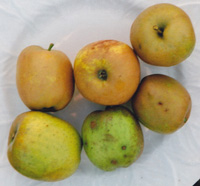 |
LITTLE
EMILY An old tree and an interesting variety, which was brought
to our notice by Mike Davidson, landscape gardener, in 2011. The tree
grows in an old hedge between arable fields and ancient woodland, north
of Wendover, Buckinghamshire, and just down from the historic Ridgeway.
It is difficult to see how it came to be there, with no other fruit trees
in the locality, and there is little knowledge of previous land use available.
It is now owned by the Forestry Commission, having formerly been part
of the Rothschild estate. It is most unusual in that the fruit is often
entirely without pips, though some have one or two. There have been old
varieties noted in the past that are seedless or without flowers, but
not in Britain in modern times. The apples are small to medium sized,
with a distinct oblong shape. The skin is pale green, becoming yellow,
with half or more covered in warm russet. The firm flesh is very sweet,
with a slightly caramel flavour, but there is barely any acid, which will
appeal to some and disappoint others. A very unusual apple, named by Mike
Davidson after his grand-daughter Emily. Mid to late season. Pollination
Group 4 |
|||
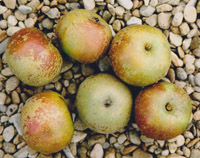 |
LODGEMORE
NONPAREIL Also called Clissold’s Seedling and Lodgemore
Seedling, it was best described by Hogg in 1884. “This is a dessert
apple of great excellence; in use from February till the beginning of
June; and is one of the best late sorts I know”. Medium sized fruit,
with rich golden yellow skin, speckled with tiny russet dots, and with
a red blush on the side near the sun. The flesh is tinted yellow, crisp,
juicy, sweet, and aromatic. Scott (1872) also rated it top quality. Barron
(1883) considered it a cider ‘sweet’. Pollination Group 7
|
|||
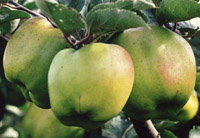 |
LONDON
PIPPIN Also known as the Five-Crowned Pippin because of its distinctive
shape, with five prominent ribs which meet around the eye. Mentioned by
Lindley in the early nineteenth century, though it is probably much older
- there are references to the ‘Loundon Pepping’ coming from
Essex in the late sixteenth century. A dual purpose late apple with crisp,
juicy flesh which keeps its shape when cooked, but which can also be used
as a dessert apple. It was once grown in Australia for export to Britain.
It stores well, not shrivelling, keeping until April. Part tip-bearing.
Good Crops. Pollination Group 5 |
|||
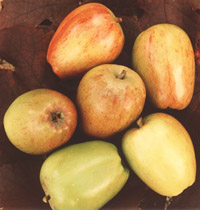 |
LONG
REINETTE An old apple variety, local to The Lee in Buckinghamshire,
now rescued from extinction. In 2001, Mr and Mrs Senior, from The Lee,
brought us some scionwood and new trees were grafted. Their very old horizontal
tree had just been identified by Percy Langston, 90 years old that year,
as a Long Runnit. A local man, he had a wide experience of the fruit traditionally
grown at The Lee, and remembered the Long Runnit as a good dessert apple
which was stored in barns, in straw, and brought out for the Christmas
table. In his youth it was widely grown around The Lee, but the old tree
owned by the Seniors appears to be the very last one. A customer recently
shared her childhood memory, that Long Reinettes were not allowed before
Christmas and were then put in the Xmas stocking! There are no records
of a Long Runnit in the historical literature, but Long Reinettes were
exhibited from Lee Manor, along with the Bazeley, at the National Apple
Congress in 1883. This is the only record of the Long Reinette. The dessert
apple is medium sized, firm, and fairly juicy with a good balance of sweetness
and acidity. The skin is green with red streaks, which are predominant
in some years and almost absent in others. As the name suggests, the shape
is very elongated, though can be shorter in some years. The fruit tends
to become softer in late autumn, but with care it will keep very well
until Christmas. Pollination Group 4 |
|||
|
||||